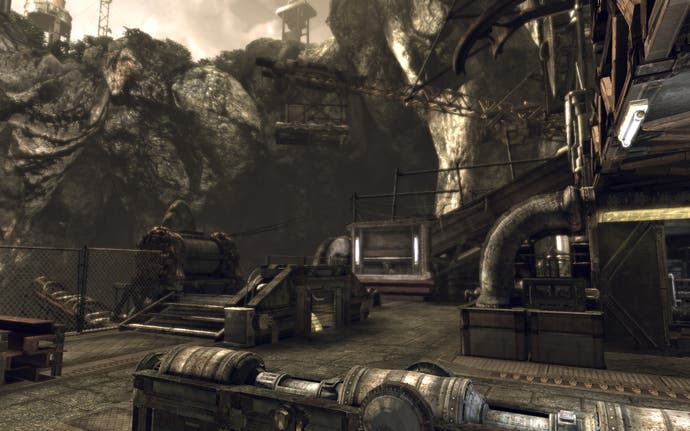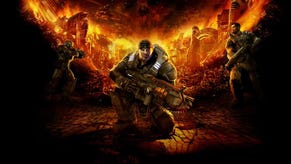Gears of War
Fenix the fight!
Billed by its creator as a game that would "place gamers directly in the shadows of a ravaged world, surrounded by the beautiful remnants of a destroyed city and the horrific dangers that hide in the rubble", Gears of War is designed to be a crowd-pleasing blockbuster. From the chainsaw bayonet to the exploding crossbow bolts, from the giant spider clawing at your helicopter to the elusive, sibilant stirrings of cloaked monsters buried deep below the earth in an ocean of golden death. It's an almost ceaseless chain of brutal skirmishes and firefights fought by tank-like muscle men who eat gravel for breakfast and sound as though they chew on wasps when they polish their armour, which isn't very often, because they're too busy washing their hands in blood. But despite its ludicrous, comical violence, its likeably primitive caveman cast and its brilliant graphics, the reasons it works are almost entirely distinct from the qualities of the action films to which its impact is often compared.
The story is so basic that it would barely cover a pamphlet, let alone a screenplay: the world is at the mercy of ground-dwelling Locust warriors, and you have to stop them. So they come out of the ground, and you kill them, which gets you closer to your objective. That's it. The triumph here is understatement, rather than execution: dialogue sequences and cut-scenes are cheesy and largely installed to break up the pace, but the fact it leaves a lot of questions unanswered gives it the closest thing it has to mystique. A lot of the clashes you face have their own timbre and recognisable characteristics, but they all follow the same script. This would make a good ride at Universal Studios, but it won't make a good film unless they have a big old think about it.
And yet it is good, because Epic has streamlined the traditional third-person combat mechanism, given you an adhesive bum and concentrated on the world you inhabit. If Halo is Combat Evolved, this is combat by intelligent design. Every battlefield is engineered to support the game's delightful central mechanic: locking yourself to the backside of a cover point with the spacebar and then pressing mouse2 to lean over the top and fire. From your first encounter on a bridge between opposing wings of a desolate prison to the final boss fight, it's all about gluing yourself to cover points and making every second of exposure count.

Sera feels like a hostile place. When the ground rumbles, it means an Emergence Hole is opening, and Locust forces are about to pin you down until they're dead. You can toss a grenade in to close one quickly, but that's only if you can get close. Otherwise you're in for a rough ride. When night falls, you have to engineer a passage of light between cover points, because the bat-like Kryll will cut you to pieces as soon as you step into shadow. But Sera has retained her dignity. Ravaged though she may be, she's actually your biggest ally; a convenient network of cover points calculated to support efficient marksmen, helpfully stocked with ammo packs and beefy guns.
It's beautifully, addictively simple, and the basic cover-to-cover combat is built upon excellent weapons. Your main assault rifle, with its chainsaw bayonet melee attack (the most absurdly and brilliantly violent finishing move since the best days of Mortal Kombat), is a gratifying mainstay, while shotguns, sniper rifles and that crossbow - with a bolt that sticks into enemies and then blows them to pieces a second later - work hard to own the slots in your limited arsenal. The best thing about the guns though is active reloading. When you press 'r', a reload bar appears under your gun in the top-right, and by pressing 'r' again as a cursor lashes across it you can affect your rate of reload. Time it so that it locks to a narrow white marker and you slam in another clip almost instantly, giving you a burst of higher-powered ammunition. Mis-time your active reload, though, and you jam your gun, wasting valuable seconds.

Coupled with cover-to-cover action, this gives Gears of War a satisfying fluidity and totality of combat control that even the best first-person shooters in the overstocked PC genre rarely achieve. And it never gets old, because the solution to each skirmish is down to the layout of your surroundings, while the fun is derived from the mechanics. Nowhere is this more apparent than in the new PC-exclusive section introduced to bridge the gap between events in Acts 4 and 5. Rocket-launching Boomers on raised platforms, turret gunners in narrow, sand-bagged corridors, Theron Guards in leafy parks, Seeders without the Hammer of Dawn... It doesn't matter if adjacent battlegrounds look alike; providing the cordons, crates, rubble and enemies are stacked differently, it will play out in a distinctive way. Epic has stumbled on a formula that only needs basic tweaks from scene to scene to remain engaging.
Gears isn't without its novelty moments, either - and while the over-zealous signposting and prompting is a legacy of dumbed-down console design, it's hard not to smile as you direct your squad-mate Dom through a plague of Kryll using a searchlight, or watch an indestructible adversary dance to death under the laser beam of an orbital death-ray.







